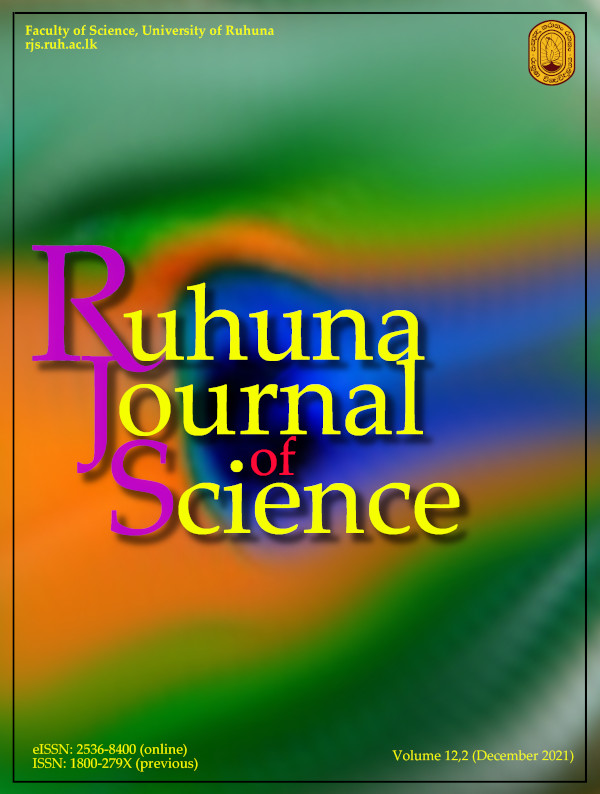Determination of the distribution of Calotropis gigantea (L.) in Sri Lanka using MaxEnt modelling technique
Abstract
Calotropis gigantea is a drought-resistant, salt-tolerant, native plant in Sri Lanka with ayurvedic medicinal values. The plant is used for fiber, fodder and fuel, as well as a fertilizer. Despite its benefits, C. gigantea has become an emerging problem in countries where it has been introduced because of its invasiveness. Although C. gigantea is widely distributed in Sri Lanka, precise information on its distribution is lacking. Therefore, the present study was aimed at determining the distribution of C. gigantea in Sri Lanka. Field surveys were conducted in 120 sites covering all provinces in Sri Lanka from December 2014 to June 2015 to record the occurrence of C. gigantea. C. gigantea was distributed in all provinces except the Central province. It was more widespread along coastal regions, but its occurrence was low in the Western and Sabaragamuwa provinces. MaxEnt modelling predicted that the entire coast of Northern, North-Central and Eastern provinces contain the highest probability of C. gigantea distribution whereas the low probability was in North-Western, Western, Southern, Uva, Central, and Sabaragamuwa provinces. No occurrence probability was predicted in certain regions of Southern, Sabaragamuwa, Uva, and Central provinces of Sri Lanka. The study provides information on the current and potential distribution range of C. gigantea in Sri Lanka. Keywords: Calotropis gigantea, MaxEnt modelling, plant distributionReferences
Austin M. 2002. Spatial prediction of species distribution: an interface between ecological theory and statistical modelling. Ecological Modelling 157: 101-118.
Azarkhavarani SF, Rahimi M, Bernardi M. 2015. The most important climatic factors affecting distribution of Zygophyllum atriplicoides in semi-arid region of Iran (Case Study: Isfahan Province). Desert 20 (2): 145-156.
Barbet-Massin M, Rome Q, Villemant C, Courchamp F. 2018. Can species distribution models really predict the expansion of invasive species? Plos ONE 13(3): e0193085.
Baard JA, Kraaij T. 2019. Use of a rapid roadside survey to detect potentially invasive plant species along the Garden Route, South Africa. Koedoe 61(1): 1-10.
Bramer I, Anderson BJ, Bennie J, Bladon AJ, De Frenne, P, Hemming D, Hill RA, Kearney MR, Korner C, Korstjens AH, Lenoir J, Maclean IMD, Marsh CD, Marecroft MD, Ohlemuller R, Slater HD, Saggitt AJ, Zellweger F, Gillingham PK. 2018. Advances in monitoring and modelling climate at ecologically relevant scales. Advances in Ecological Research 58: 101-161.
Dhileepan K. 2014. Prospects for the classical biological control of Calotropis procera (Apocynaceae) using coevolved insects. Biocontrol Science and Technology 24(9): 977-998.
Fick SE, Hijmans RJ. 2017. WorldClim 2: new 1-km spatial resolution climate surfaces for global land area. International Journal of Climatology, 37 (12).
Honnay O, Hermy M, Coppin, P. 1999. Impact of habitat quality on forest plant species colonization. Forest Ecology and Management 115 (2-3): 157-170.
Kumar D, Kumar S. 2015. Calotropis gigantea (L.) Dryand – A review update. Indian Journal of Research in Pharmacy and Biotechnology 3(3): 218-230.
Kumar P, Suresh E, Kalavath S. 2013. Review on a potential herb Calotropis gigantea (L.) R. Br. Scholars Academic Journal of Pharmacy 2(2): 135-143.
Menge EO, Bellairs SM, Lawes MJ. 2017. Disturbance-dependent invasion of the woody weed, Calotropis procera, in Australian rangelands. The Rangeland Journal 39: 201-211.
Menge EO, Stobo-Wilson A, Oliveira SL, Lawes MJ. 2016. The potential distribution of the woody weed Calotropis procera (Aiton) W.T. Aiton (Asclepiadaceae) in Australia. The Rangeland Journal 38(1): 35-46.
Merow C, Smith MJ, Silander JA. 2013. A practical guide to MaxEnt for modelling species’ distributions: what it does, and why inputs and settings matter. Ecography 36(10): 1058-1069.
Naiman RJ, Decamps H, McClain ME, Likens GE. 2005. Biotic Functions of Riparia, California, 1st edition, Elsevier academic press, California, 1-488pp.
Pidwirny M. 2018. Spatial distribution of species and Ecosystems. British Columbia, Our planet Earth publishing
Quazi S, Mathur K, Arora S. 2013. Calotropis procera: An overview of its Phytochemistry and pharmacology. Indian Journal of Drugs 1(2): 63-69.
Reddy M, Begum H, Sunil N, Pandravada S, Sivara N. 2015. Mapping the climate suitability using MaxEnt modelling approach for Ceylon Spinach (Basellaalba L.) cultivation in India. The journal of agricultural sciences 10(2): 87-97.
Sharma GP, Kumar M, Raghubanshi AS. 2010. Urbanization and road-use determines Calotropis procera distribution in the eastern Indo-Gangetic plain, India. Ambio 39(2): 194–197.
Uden DR, Allen CR, Angeler DG, Corral L, Fricke, KA. 2015. Adaptive invasive species distribution models: a framework for modelling incipient invasions. Biological Invasions 17 (10): 831-2850.
Young N, Carter L, Evangelista P. 2011. A MaxEnt Model v3.3.3e Tutorial (ArcGIS v10). Colarado: Colarado State University.
Downloads
Published
Issue
Section
License
From Volume 7 (2016) onwards, all articles published in Ruhuna Journal of Science are Open Access articles published under the Creative Commons CC BY-NC 4.0 International License. This License permits use, distribution and reproduction in any medium, provided the original work is properly cited and is not used for commercial purposes.
Copyright on any research article published in RJS is retained by the respective author(s).
Authors who publish with this journal agree to the following terms:
a) Authors retain copyright and grant the journal right of first publication with the work simultaneously licensed under a Creative Commons Attribution License CC-BY-NC 4.0 International, that allows others to share the work with an acknowledgement of the work's authorship and initial publication in this journal.
b) Authors are able to enter into separate, additional contractual arrangements for the non-exclusive distribution of the journal's published version of the work (e.g., post it to an institutional repository or publish it in a book), with an acknowledgement of its initial publication in this journal.
c) Authors are permitted and encouraged to post their work online (e.g., in institutional repositories or on their website) prior to and during the submission process, as it can lead to productive exchanges, as well as earlier and greater citation of published work (See The Effect of Open Access).

